2002 BMW 525I SPORT WAGON fuel fill door release
[x] Cancel search: fuel fill door releasePage 24 of 186
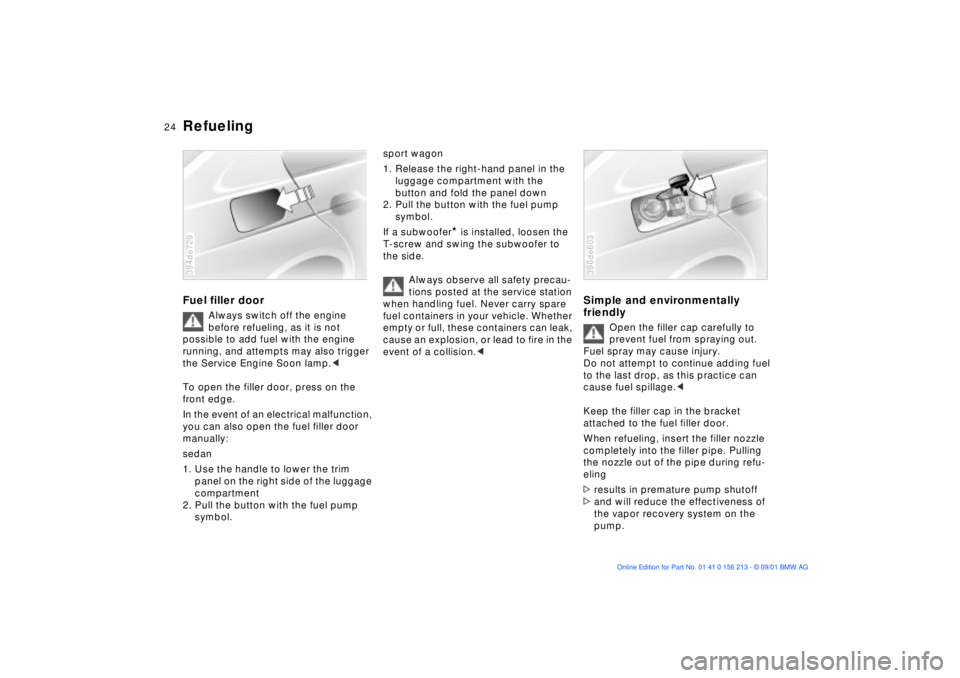
24n
RefuelingFuel filler door
Always switch off the engine
before refueling, as it is not
possible to add fuel with the engine
running, and attempts may also trigger
the Service Engine Soon lamp.<
To open the filler door, press on the
front edge.
In the event of an electrical malfunction,
you can also open the fuel filler door
manually:
sedan
1. Use the handle to lower the trim
panel on the right side of the luggage
compartment
2. Pull the button with the fuel pump
symbol.
394de729
sport wagon
1. Release the right-hand panel in the
luggage compartment with the
button and fold the panel down
2. Pull the button with the fuel pump
symbol.
If a subwoofer
* is installed, loosen the
T-screw and swing the subwoofer to
the side.
Always observe all safety precau-
tions posted at the service station
when handling fuel. Never carry spare
fuel containers in your vehicle. Whether
empty or full, these containers can leak,
cause an explosion, or lead to fire in the
event of a collision.<
Simple and environmentally
friendly
Open the filler cap carefully to
prevent fuel from spraying out.
Fuel spray may cause injury.
Do not attempt to continue adding fuel
to the last drop, as this practice can
cause fuel spillage.<
Keep the filler cap in the bracket
attached to the fuel filler door.
When refueling, insert the filler nozzle
completely into the filler pipe. Pulling
the nozzle out of the pipe during refu-
eling
>results in premature pump shutoff
>and will reduce the effectiveness of
the vapor recovery system on the
pump.
390de603
Page 32 of 186
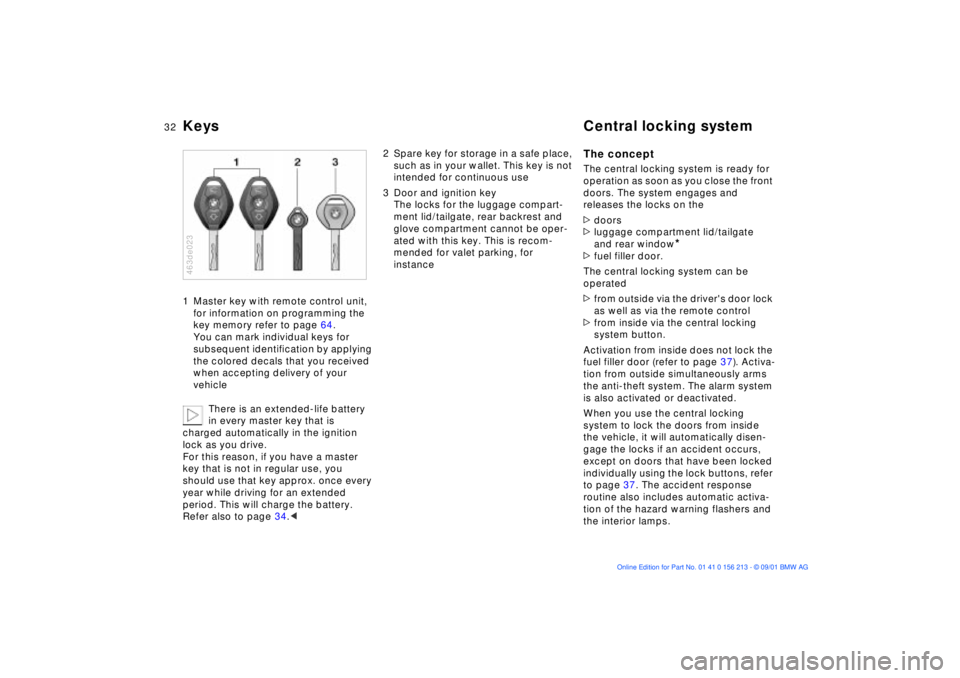
32n
Keys Central locking system1 Master key with remote control unit,
for information on programming the
key memory refer to page 64.
You can mark individual keys for
subsequent identification by applying
the colored decals that you received
when accepting delivery of your
vehicle
There is an extended-life battery
in every master key that is
charged automatically in the ignition
lock as you drive.
For this reason, if you have a master
key that is not in regular use, you
should use that key approx. once every
year while driving for an extended
period. This will charge the battery.
Refer also to page 34.< 463de023
2 Spare key for storage in a safe place,
such as in your wallet. This key is not
intended for continuous use
3 Door and ignition key
The locks for the luggage compart-
ment lid/tailgate, rear backrest and
glove compartment cannot be oper-
ated with this key. This is recom-
mended for valet parking, for
instance
The conceptThe central locking system is ready for
operation as soon as you close the front
doors. The system engages and
releases the locks on the
>doors
>luggage compartment lid/tailgate
and rear window
*
>fuel filler door.
The central locking system can be
operated
>from outside via the driver's door lock
as well as via the remote control
>from inside via the central locking
system button.
Activation from inside does not lock the
fuel filler door (refer to page 37). Activa-
tion from outside simultaneously arms
the anti-theft system. The alarm system
is also activated or deactivated.
When you use the central locking
system to lock the doors from inside
the vehicle, it will automatically disen-
gage the locks if an accident occurs,
except on doors that have been locked
individually using the lock buttons, refer
to page 37. The accident response
routine also includes automatic activa-
tion of the hazard warning flashers and
the interior lamps.
Page 33 of 186

33n
OverviewControlsMaintenanceRepairsDataIndex
Opening and closing Ð via the door lockUsing the keyOne turn of the key in the driver's door
lock unlocks the driver's door only.
Turning the key a second time unlocks
all of the remaining doors, the luggage
compartment lid/tailgate and the fuel
filler door.
You can have a signal set to
confirm that the vehicle's locks
have engaged securely.< 390de723
Convenience operationYou can also operate the windows and
sliding/tilt sunroof via the door lock.
>To open: with the door closed, turn
the key to the "Unlock" position and
hold it
>To close: with the door closed, turn
the key to the "Lock" position and
hold it.
Watch the closing process care-
fully and be sure that no one is
trapped by the closing motion. The
closing process stops immediately
when you release the key.< Manual operationin the event of an electrical malfunction
Turn the key to the extreme left or right
to unlock/lock the driver's door.
Page 37 of 186
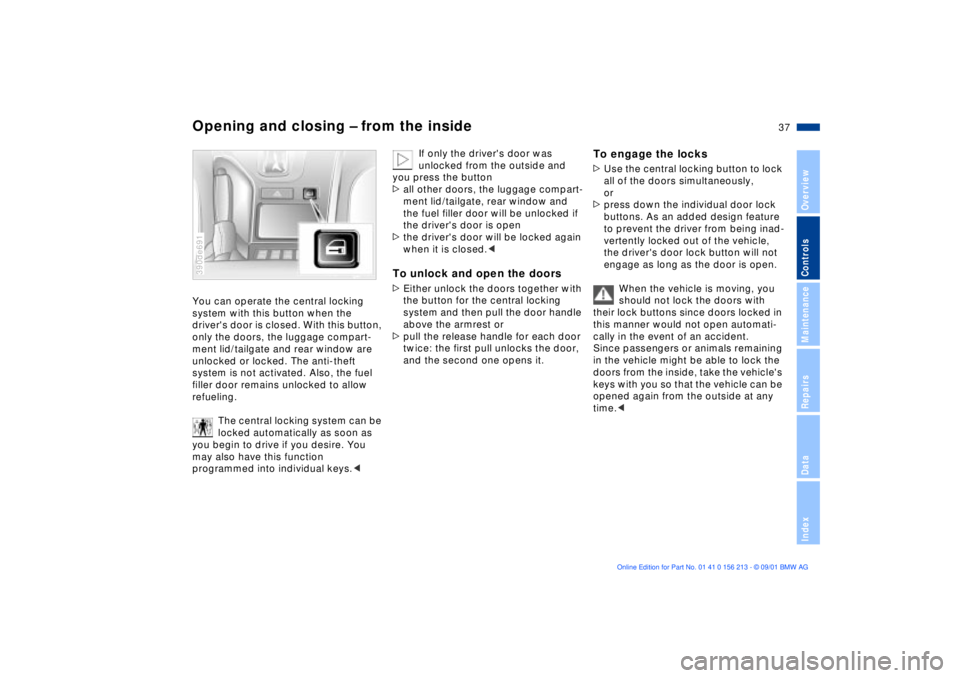
37n
OverviewControlsMaintenanceRepairsDataIndex
Opening and closing Ð from the insideYou can operate the central locking
system with this button when the
driver's door is closed. With this button,
only the doors, the luggage compart-
ment lid/tailgate and rear window are
unlocked or locked. The anti-theft
system is not activated. Also, the fuel
filler door remains unlocked to allow
refueling.
The central locking system can be
locked automatically as soon as
you begin to drive if you desire. You
may also have this function
programmed into individual keys.< 390de691
If only the driver's door was
unlocked from the outside and
you press the button
>all other doors, the luggage compart-
ment lid/tailgate, rear window and
the fuel filler door will be unlocked if
the driver's door is open
>the driver's door will be locked again
when it is closed.<
To unlock and open the doors>Either unlock the doors together with
the button for the central locking
system and then pull the door handle
above the armrest or
>pull the release handle for each door
twice: the first pull unlocks the door,
and the second one opens it.
To engage the locks>Use the central locking button to lock
all of the doors simultaneously,
or
>press down the individual door lock
buttons. As an added design feature
to prevent the driver from being inad-
vertently locked out of the vehicle,
the driver's door lock button will not
engage as long as the door is open.
When the vehicle is moving, you
should not lock the doors with
their lock buttons since doors locked in
this manner would not open automati-
cally in the event of an accident.
Since passengers or animals remaining
in the vehicle might be able to lock the
doors from the inside, take the vehicle's
keys with you so that the vehicle can be
opened again from the outside at any
time.<
Page 84 of 186
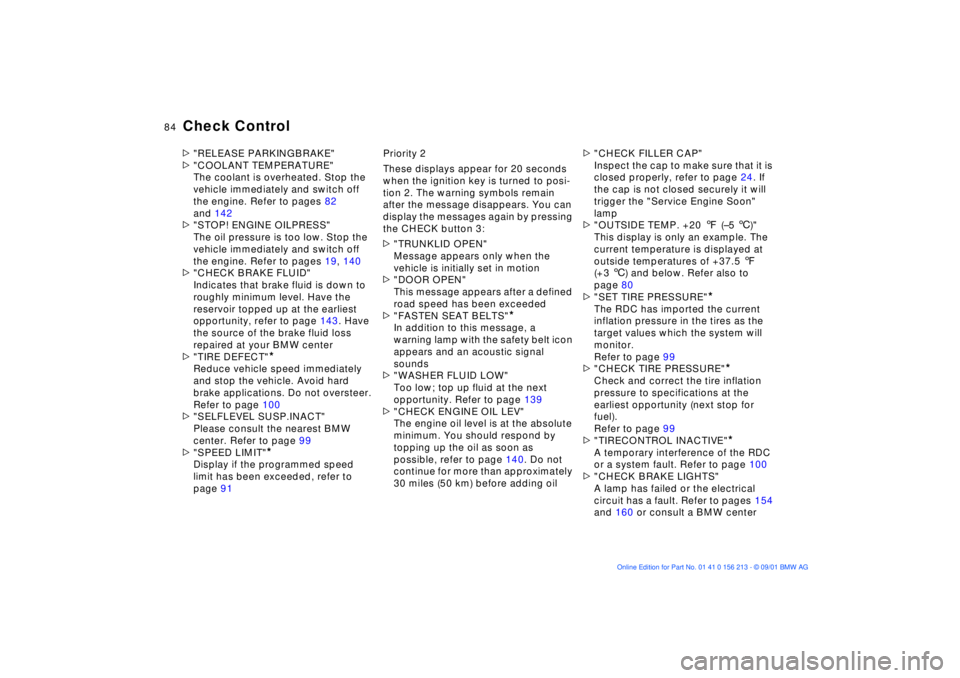
84n
Check Control>"RELEASE PARKINGBRAKE"
>"COOLANT TEMPERATURE"
The coolant is overheated. Stop the
vehicle immediately and switch off
the engine. Refer to pages 82
and 142
>"STOP! ENGINE OILPRESS"
The oil pressure is too low. Stop the
vehicle immediately and switch off
the engine. Refer to pages 19, 140
>"CHECK BRAKE FLUID"
Indicates that brake fluid is down to
roughly minimum level. Have the
reservoir topped up at the earliest
opportunity, refer to page 143. Have
the source of the brake fluid loss
repaired at your BMW center
>"TIRE DEFECT"
*
Reduce vehicle speed immediately
and stop the vehicle. Avoid hard
brake applications. Do not oversteer.
Refer to page 100
>"SELFLEVEL SUSP.INACT"
Please consult the nearest BMW
center. Refer to page 99
>"SPEED LIMIT"
*
Display if the programmed speed
limit has been exceeded, refer to
page 91Priority 2
These displays appear for 20 seconds
when the ignition key is turned to posi-
tion 2. The warning symbols remain
after the message disappears. You can
display the messages again by pressing
the CHECK button 3:
>"TRUNKLID OPEN"
Message appears only when the
vehicle is initially set in motion
>"DOOR OPEN"
This message appears after a defined
road speed has been exceeded
>"FASTEN SEAT BELTS"
*
In addition to this message, a
warning lamp with the safety belt icon
appears and an acoustic signal
sounds
>"WASHER FLUID LOW"
Too low; top up fluid at the next
opportunity. Refer to page 139
>"CHECK ENGINE OIL LEV"
The engine oil level is at the absolute
minimum. You should respond by
topping up the oil as soon as
possible, refer to page 140. Do not
continue for more than approximately
30 miles (50 km) before adding oil>"CHECK FILLER CAP"
Inspect the cap to make sure that it is
closed properly, refer to page 24. If
the cap is not closed securely it will
trigger the "Service Engine Soon"
lamp
>"OUTSIDE TEMP. +20 7 (Ð5 6)"
This display is only an example. The
current temperature is displayed at
outside temperatures of +37.5 7
(+3 6) and below. Refer also to
page 80
>"SET TIRE PRESSURE"
*
The RDC has imported the current
inflation pressure in the tires as the
target values which the system will
monitor.
Refer to page 99
>"CHECK TIRE PRESSURE"
*
Check and correct the tire inflation
pressure to specifications at the
earliest opportunity (next stop for
fuel).
Refer to page 99
>"TIRECONTROL INACTIVE"
*
A temporary interference of the RDC
or a system fault. Refer to page 100
>"CHECK BRAKE LIGHTS"
A lamp has failed or the electrical
circuit has a fault. Refer to pages 154
and 160 or consult a BMW center
Page 178 of 186
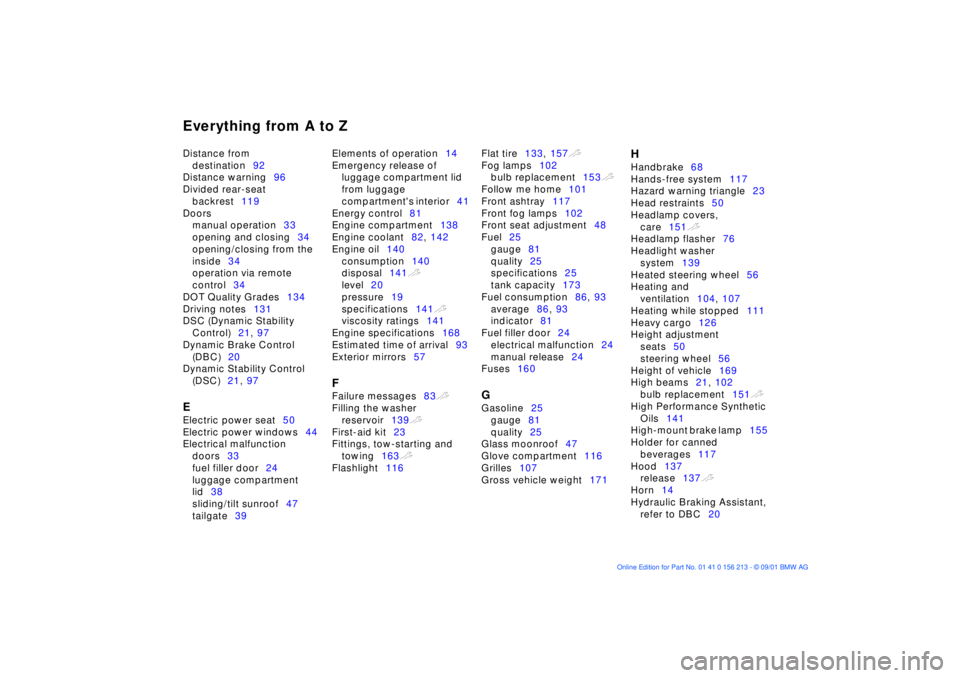
Everything from A to ZDistance from
destination92
Distance warning96
Divided rear-seat
backrest119
Doors
manual operation33
opening and closing34
opening/closing from the
inside34
operation via remote
control34
DOT Quality Grades134
Driving notes131
DSC (Dynamic Stability
Control)21, 97
Dynamic Brake Control
(DBC)20
Dynamic Stability Control
(DSC)21, 97 E
Electric power seat50
Electric power windows44
Electrical malfunction
doors33
fuel filler door24
luggage compartment
lid38
sliding/tilt sunroof47
tailgate39 Elements of operation14
Emergency release of
luggage compartment lid
from luggage
compartment's interior41
Energy control81
Engine compartment138
Engine coolant82, 142
Engine oil140
consumption140
disposal141t
level20
pressure19
specifications141t
viscosity ratings141
Engine specifications168
Estimated time of arrival93
Exterior mirrors57
F
Failure messages83t
Filling the washer
reservoir139t
First-aid kit23
Fittings, tow-starting and
towing163t
Flashlight116 Flat tire133, 157t
Fog lamps102
bulb replacement153t
Follow me home101
Front ashtray117
Front fog lamps102
Front seat adjustment48
Fuel25
gauge81
quality25
specifications25
tank capacity173
Fuel consumption86, 93
average86, 93
indicator81
Fuel filler door24
electrical malfunction24
manual release24
Fuses160
G
Gasoline25
gauge81
quality25
Glass moonroof47
Glove compartment116
Grilles107
Gross vehicle weight171
H
Handbrake68
Hands-free system117
Hazard warning triangle23
Head restraints50
Headlamp covers,
care151t
Headlamp flasher76
Headlight washer
system139
Heated steering wheel56
Heating and
ventilation104, 107
Heating while stopped111
Heavy cargo126
Height adjustment
seats50
steering wheel56
Height of vehicle169
High beams21, 102
bulb replacement151t
High Performance Synthetic
Oils141
High-mount brake lamp155
Holder for canned
beverages117
Hood137
release137t
Horn14
Hydraulic Braking Assistant,
refer to DBC20
Page 179 of 186
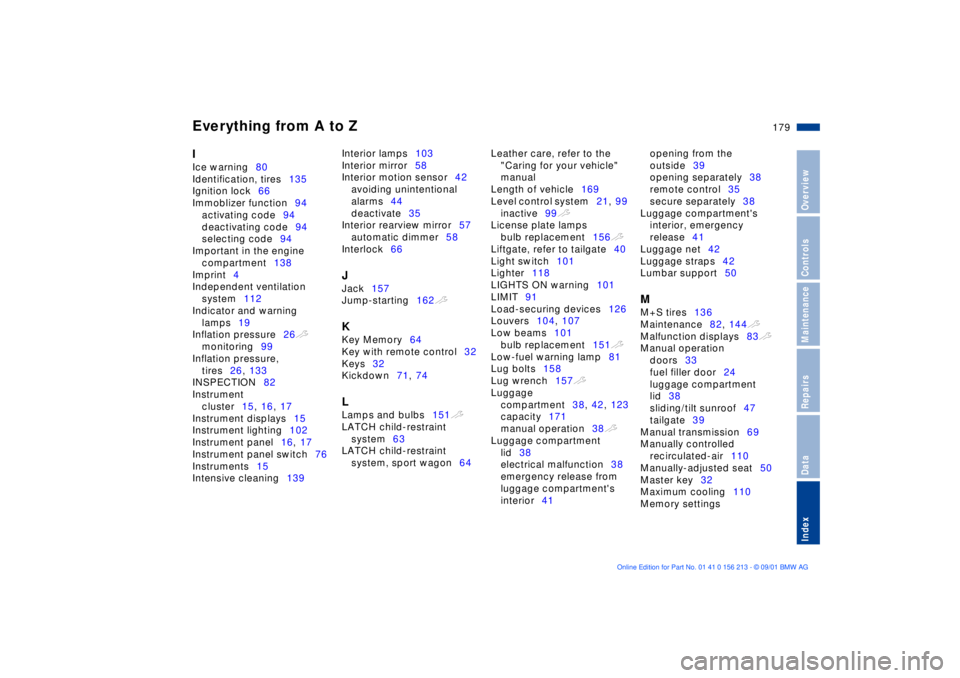
Everything from A to Z
179n
OverviewControlsMaintenanceRepairsDataIndex
I
Ice warning80
Identification, tires135
Ignition lock66
Immoblizer function94
activating code94
deactivating code94
selecting code94
Important in the engine
compartment138
Imprint4
Independent ventilation
system112
Indicator and warning
lamps19
Inflation pressure26t
monitoring99
Inflation pressure,
tires26, 133
INSPECTION82
Instrument
cluster15, 16, 17
Instrument displays15
Instrument lighting102
Instrument panel16, 17
Instrument panel switch76
Instruments15
Intensive cleaning139 Interior lamps103
Interior mirror58
Interior motion sensor42
avoiding unintentional
alarms44
deactivate35
Interior rearview mirror57
automatic dimmer58
Interlock66
J
Jack157
Jump-starting162t K
Key Memory64
Key with remote control32
Keys32
Kickdown71, 74 L
Lamps and bulbs151t
LATCH child-restraint
system63
LATCH child-restraint
system, sport wagon64 Leather care, refer to the
"Caring for your vehicle"
manual
Length of vehicle169
Level control system21, 99
inactive99t
License plate lamps
bulb replacement156t
Liftgate, refer to tailgate40
Light switch101
Lighter118
LIGHTS ON warning101
LIMIT91
Load-securing devices126
Louvers104, 107
Low beams101
bulb replacement151t
Low-fuel warning lamp81
Lug bolts158
Lug wrench157t
Luggage
compartment38, 42, 123
capacity171
manual operation38t
Luggage compartment
lid38
electrical malfunction38
emergency release from
luggage compartment's
interior41 opening from the
outside39
opening separately38
remote control35
secure separately38
Luggage compartment's
interior, emergency
release41
Luggage net42
Luggage straps42
Lumbar support50
M
M+S tires136
Maintenance82, 144t
Malfunction displays83t
Manual operation
doors33
fuel filler door24
luggage compartment
lid38
sliding/tilt sunroof47
tailgate39
Manual transmission69
Manually controlled
recirculated-air110
Manually-adjusted seat50
Master key32
Maximum cooling110
Memory settings